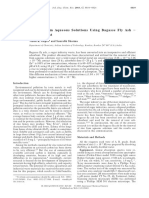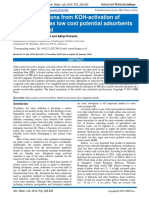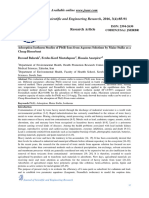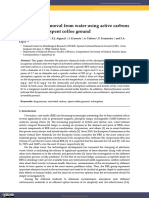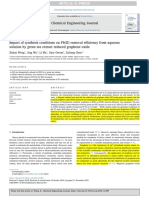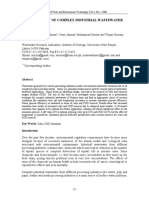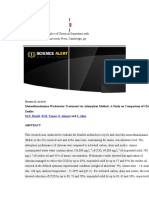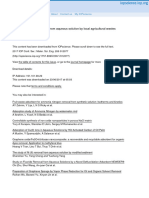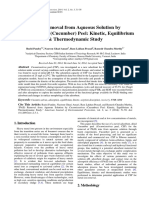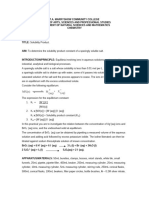Modification of Pomegranate Waste With Iron Ions A
Modification of Pomegranate Waste With Iron Ions A
Uploaded by
syazella1Copyright:
Available Formats
Modification of Pomegranate Waste With Iron Ions A
Modification of Pomegranate Waste With Iron Ions A
Uploaded by
syazella1Original Title
Copyright
Available Formats
Share this document
Did you find this document useful?
Is this content inappropriate?
Copyright:
Available Formats
Modification of Pomegranate Waste With Iron Ions A
Modification of Pomegranate Waste With Iron Ions A
Uploaded by
syazella1Copyright:
Available Formats
Salmani et al.
AMB Expr (2017) 7:225
https://doi.org/10.1186/s13568-017-0520-0
ORIGINAL ARTICLE Open Access
Modification of pomegranate waste
with iron ions a green composite for removal
of Pb from aqueous solution: equilibrium,
thermodynamic and kinetic studies
Mohammad Hossein Salmani1*, Mohammad Abedi2, Sayed Ahmad Mozaffari2 and Hossien Ali Sadeghian3
Abstract
Pomegranate waste modified with Fe2+ and Fe3+ ions followed with carbonization were used as an adsorbent to
remove the Pb2+ ions from aqueous solution. To optimum the highest adsorption efficiency, adsorption experiments
were conducted on iron modified carbons by batch technique. The characteristic of composite was studied by scan-
ning electron microscope (SEM) and Fourier transform infrared spectrometer (FT-IR). The best pH for control of chemi-
cal adsorption was selected within pH of 6.0–6.5. It was observed that the contact time of 90 min, initial concentration
50.0 ppm, and adsorbent dose, 1.0 g/100 ml solution was found to be optimum conditions. On this condition, the
maximum adsorption capacity was obtained 27.5 and 22.5 mg/g for Fe2+ and Fe3+ impregnated pomegranate peel
carbons (PPC), respectively. The value of Cid, 1.584 for Fe2+-PPC and 0.552 for Fe3+-PPC, indicates that the effect of
the boundary layer is more important in adsorption of Pb2+ by Fe2+-PPC and the pore diffusion is the rate limiting
mechanism after 30 min. Thermodynamic parameters of Gibbs free energy, enthalpy, and entropy of P b2+ adsorp-
tion on iron-modified carbons suggest that the adsorption process is favorable and spontaneous under the optimum
condition.
Keywords: Iron modified carbon, Pomegranate peels, Composite, Thermodynamic, Kinetic
Introduction such as ion exchange, coagulation, electrochemical pro-
Lead is known as the heavy metals, which is strongly cess, reverse osmosis, and ion flotation (Ehrampoush
toxic to humans, animals, and plants. Inter of lead to et al. 2015). These methods are costly and produce the
the human body even at low concentrations causes seri- secondary wastes. One of the high-performance and
ous problems to the nervous and reproductive system, low-cost methods for removing of ionic pollutants from
kidney, liver, brain and bony tissues (Grant 2008; Ren- aqueous solutions is adsorption. However, the cost of
ner 2010; Andrade et al. 2015). Environmental Protection used adsorbents and their separation from suspension
Agency (EPA) approved the maximum threshold limit of after adsorption are the important restricting factors in
0.015 ppm for lead in drinking water. The removal of lead perspective on the applicability of adsorption process.
from wastewaters, before discharging to aquatic environ- Recently, considerable notation has been given to the
ment, in high concentration is accomplished by common development of substitutes from readily available and
processes, including precipitation with hydroxide ion or cheaper materials such as agricultural wastes for prepara-
lime and in low concentration by advanced processes tion of activated carbon to remove pollutants to approach
the standard levels (Babel and Kurniawan 2003). Until
now, using of low-cost agricultural sorbents, including
*Correspondence: mhsn06@yahoo.com
1
Ponkan peel (Pavan et al. 2008), waste tea leaves (Cher-
Department of Environmental Health, School of Public Health, Shahid
Sadoughi University of Medical Science, Yazd, Islamic Republic of Iran
aghi et al. 2015), potato peel (Taha et al. 2011), modi-
Full list of author information is available at the end of the article fied onion skins (Saka et al. 2011), the activate carbon
© The Author(s) 2017. This article is distributed under the terms of the Creative Commons Attribution 4.0 International License
(http://creativecommons.org/licenses/by/4.0/), which permits unrestricted use, distribution, and reproduction in any medium,
provided you give appropriate credit to the original author(s) and the source, provide a link to the Creative Commons license,
and indicate if changes were made.
Content courtesy of Springer Nature, terms of use apply. Rights reserved.
Salmani et al. AMB Expr (2017) 7:225 Page 2 of 8
of peanut shell (Wilson et al. 2006), pistachio shell, and and Fe2+ solutions for 12 h, separately. The impregnated
apricot stone (Kazemipour et al. 2008), have been exam- granules were dried and then carbonized at 400 °C for
ined for removing of P b2+ ions from aqueous solutions. 3 h into a programmable furnace in the absence of air.
Pomegranate wastes as a by-product of juice, jams, The residual was washed 3 times with distilled water to
syrup, and sauce manufacturing industries, which pro- eject excess ions from the modified carbons. Eventually,
duced in large amounts in Iran. The peels include about the iron modified carbons were heated at 105 °C, named
45–50% of the total weight of fruit. The fruit peels have Fe2+-PPC and Fe3+-PPC and maintain for further uses.
a strong affinity and high selection towards heavy metals
because of the various functional groups on the surface Calibration
of it. Hence, the idea to change the by-product of pome- The ranges of the calibration curves (0–50 ppm) for P b2+
granate fruit to iron impregnation carbon for cleaning of the samples were selected for calibration of AAS. For
the environment and removing of heavy metal is valu- this purpose, the absorbance of standard solutions was
able. Abedi et al. impregnated of Fe2+ and Fe3+ ions to constructed versus concentration at a maximum wave-
the PPC were studied to remove Cd(II) ions (Abedi et al. length of 283.3 nm. Detection and quantification limits
2016). were defined as the lowest concentrations of a compo-
Considering the above descriptions, we used as an nent that produces a signal equal to three and ten times
adsorbent the iron modification of PPCs for removing of the standard deviation for a series of the blank solu-
of Pb2+ from aqueous solution by one factor at a time tion. The following equations were used for calculation of
methodology. The main objective of this work is to obtain the detection (DL) and quantification (QL) limit:
the adsorption kinetic and thermodynamic parameters
3.3 ∗ σ A
for the adsorption reaction of Pb2+ ions with prepared D.L. = (1)
composite. m
The adsorption process depends on many factors
10 ∗ σ A
including pH, temperature, adsorbent mass, concentra- Q.L. = (2)
tion of pollutant, adsorbent type, contact time and agita- m
tion time. In the present study, the effect of initial lead DL and QL are the detection and quantification limit, σA
concentration, adsorbent dose, and temperature was is the standard deviation of the intercept, and m is the
screened for removing of Pb2+ ions by Fe2+ and Fe3+ slope of the calibration of linear equation.
impregnated into PPC adsorbents. The experiments were
performed in batch technique and adsorption capacity Experiments
was calculated in the each step. Then, the plot of adsorp- To obtain optimal conditions, the effect of contact time,
tion capacity via parameter changes was used to choose initial Pb2+ concentration, and adsorbent dose were
the optimum amount of each factor. determined at laboratory temperature (27 °C) based on
the following experiments:
Materials and methods The effect of initial P b2+ concentration was studied
Reagents using 0.2 g of adsorbents and 50 ml of different concen-
All of the chemicals used in this work were of analytical trations of Pb2+ solution in the range of 10, 25, 50, 75 and
grade. The 100 ppm stock solution of P b2+ was prepared 100 ppm in the screw-capped containers. The influence
by dissolving of Pb(NO3)2 in distilled water. The FeCl3 of composite dose on P b2+ adsorption was examined by
and FeCl2 solutions were used for modification of pome- taking 50 ml of 50 ppm of Pb2+ solutions and shaking
granate peels. Five standard solutions of 0.0, 5.0, 10.0, with varying amounts of adsorbents in ranging from 0.1
25.0, 50.0 ppm were made from a solution of 100 ppm to 1.5 g. The similar solutions without adsorbents as con-
by dilution with 1% (v/v) HNO3 for calibration of atomic trol samples were examined in parallel. All of the batch
absorption spectrometer (AAS). The working solutions experiments were performed at solution pH of 6.5 in the
with desired P b2+ concentration were daily made by dilu- 150 ml closed containers and constant shaker 180 RPM
tion of the stock solution. using a shaker equipped with an electrical heater. At the
end of all the experiments, the suspension was filtered
Preparation of composites and the concentration of P b2+ in the filtered solution
Pomegranate wastes were collected from Agro Indus- was measured by AAS that it was calibrated, previously.
tries Co in Fars province, Iran. They were dried at labo- According to the obtained data, the adsorption capacity
ratory temperature in the absence of sunlight and sized (q) of adsorbents (mg/g) was determined by the differ-
in mesh 40–100 by standard sieves. To modify them, ence of initial and equilibrium concentration using the
10 g of the granules were mixed with 10 ml of 0.1 M Fe3+ mass balance equation, as follows:
Content courtesy of Springer Nature, terms of use apply. Rights reserved.
Salmani et al. AMB Expr (2017) 7:225 Page 3 of 8
programmable orbital shaker. The experimental data
V
qt = (C0 − Ce) × (3) were applied to determination of thermodynamic distri-
m bution constant as follows:
Where C0 and C b2+ in
e are ion concentrations (mg/l) of P
Cs
solution at initial and equilibrium time, respectively, m is K = (5)
the mass of adsorbent (g) and V is the volume of solution Ce
(ml). The Gibbs free energy (ΔG), entropy (ΔS) and enthalpy
(ΔH) were obtained from the Eqs. 6 and 7:
Adsorption kinetic
For evaluation of information the kinetic adsorption G = −RT ln K (6)
mechanism, a satisfactory selection of model is required.
S H 1
Different adsorption models are available for designing lnk = + (7)
of the adsorption rate a system. In the present study, five R R T
batch adsorption experiments were conducted by varia- where K and R are the equilibrium and the universal
tion of contact time from 10 min up to 120 min related to gas constant (8.314 J/mol °K), C s and C
e are ion con-
kinetic studies. The obtained data were fitted to intrapar- centrations adsorbed on the solid phase (mol/g) and
ticle diffusion model in order to consider the adsorption in equilibrium liquid phase (mol/l), and T is the abso-
mechanism and rate limiting step in the adsorption pro- lute temperature °K. According to Eq. 7, enthalpy func-
cess which expressed by Weber–Morris as follows: tion was calculated from the slope and entropy from the
intercept of the line of lnK against 1/T.
qt = kid t 1/2 + Cid (4)
Where qt is the adsorption capacity (mg/g), kid (mg/g/ Results
min) is the intraparticle rate constant and intercept of Cid SEM
(mg/g) related to the thickness of the boundary layer. SEM is a powerful magnification tool that produces
images of a sample by scanning the surface with a focused
Adsorption thermodynamic beam of electrons to obtain information. The electrons
For investigation of thermodynamic parameters, the interact with the atoms in a sample, producing various
equilibrium adsorption experiments were performed signals that contain information about the topology of
by taking 50 ppm Pb2+ solution using 0.1 g of adsor- sample surface. Figure 1a, b shows the SEM photographs
bents at temperatures 25, 55 and 85 °C on a temperature of the PPCs without and with impregnation of iron ions.
Fig. 1 SEM images of adsorbents prepared for adsorption of Pb. SEMs were recorded in the acceleration voltage 15.00 kV and magnitude ×100.00
for focusing on surface porous. a SEM image of pomegranate peel carbon and b iron modified pomegranate peel carbon. There was a significant
difference of porous between two image corresponding modifications
Content courtesy of Springer Nature, terms of use apply. Rights reserved.
Salmani et al. AMB Expr (2017) 7:225 Page 4 of 8
FT‑IR Table 1 The results of AA calibration for measurement
FT-IR instrument is a good tool to identify the character- of Pb2+
istic of functional groups in a compound. The main func- Concentration No. of replicates Mean value SD
tional groups found in Fe2+-PPC by adsorption spectra in of Pb2+ (ppm) of signal
the infrared region, which illustrated in Fig. 2.
0.0 20 0.0037 0.01108
5.0 5 0.1718 0.00227
Analytical sensitivity and detection limit
10.0 5 0.3312 0.00368
A calibration of absorbance versus concentration was
25.0 5 0.8526 0.00225
constructed using 5 points of varying concentration. The
50.0 5 1.7070 0.00574
following replicate data are presented in Table 1.
Linearity of methods was checked within the
0–50 ppm. An analysis of the calibration data for the optimum of the effective parameters on the adsorption
determination of Pb2+ based upon its AAS yielded the capacity of Fe2+ and Fe3+ impregnation to pomegranate
following equation: peel carbons for adsorption of P b2+ ions from equation
solution.
S = 0.0037 (± 0.0111) × C + 0.03463 (± 0.000434)
(8)
Effect of time
R2 = 0.9996 SE = 0.0132 F = 6349.17 P-value = 0.0001. The results of experiments (Fig. 3) conducted to obtain
The statistical parameters show that the analytical the equilibrium time required for the uptake of Pb2+
method for determination of P b2+ had suitable calibration. e2+-PPC and F
ions by two adsorbents. For F e3+-PPC, 8.8
Sensitivity is the response of the instrument to changes in and 8.6 mg of lead were adsorbed in the unit of adsor-
analyte concentration or a measure of the ability of method bent mass at the 90 min, respectively. The uptake of
to distinguish between small differences in concentration e2+-PPC and F
metal ions for F e3+-PPC decreased to 8.6
in different samples. The sensitivity was obtained from and 7.9 mg/g after 120 min. In general, the total capac-
the slope of the calibration curve. The detection limit is ity adsorption of Fe2+-PPC and Fe3+-PPC was achieved
defined as the lowest concentration of the component, constant in the 90 min. Therefore, in subsequent experi-
which will generate a signal/noise ratio of 3. The detection ments, 90 min was selected for contact times.
and quantification limit value were obtained from Eqs. 1
and 2. The results are represented in Table 2. Effect of initial concentration
Preliminary experiments showed that iron modified Pb2+ con-
Figure 4 represents the effect of initial
pomegranate peel carbonized at 400 °C gives the high- centrations on the adsorption capacity of Fe2+-PPC
est adsorption for P b2+ ions in aqueous solution. There- 3+
and Fe -PPC at pH of 6.5. The finding showed that
fore, several batch experiments were done to find out the b2+ increased from 3.2
the adsorption capacity of P
Fig. 2 FT-IR spectrum of Fe2+ modified pomegranate peel carbon
Content courtesy of Springer Nature, terms of use apply. Rights reserved.
Salmani et al. AMB Expr (2017) 7:225 Page 5 of 8
Table 2 Linearity, limit of detection and quantification
for the AA
Parameters Value
Linearity range 1–50 ppm
Intercept 0.0037 ± 0.0111
Slop 0.0346 ± 0.00043
Correlation coefficient ( R2) 0.9996
Probability (P) < 0.0001
Detection limit (D.L.) 1.050 mg/l
Quantification limit (Q.L.) 3.200 mg/l
Fig. 5 The effect of composite dose on adsorption capacity. The
change of adsorption capacity in removal of the Pb2+ vs amount
of adsorbents in solution for Fe2+-PPC is depicted in red and for
Fe3+-PPC is depicted in blue
shows the plot of adsorption capacity of Fe2+-PPC and
Fe3+-PPC to uptake of Pb2+ versus adsorbent doses. The
adsorption of Pb2+ increased from 25.1 and 24.2 to 26.7
and 25.4 mg/g with an increase in adsorbent dose from
0.10 to 1.0 w/v% for Fe2+-PPC and F
e3+-PPC respectively.
With increasing of the adsorbent dose to 1.5 w/v%, the
adsorption capacity decreased from 26.7 and 25.4 to 14.6
and 13.0 mg/g further.
Fig. 3 The effect of contact time on adsorption capacity. The
change of adsorption capacity in removal of Pb2+ vs contact time for
Fe2+-PPC is depicted in red and for Fe3+-PPC is depicted in blue Kinetic
In this work, the experimental data were fitted to the
intraparticle diffusion equation that was given by Weber
and Morris equation as Eq. 3. Figure 6 represents the plot
of qt versus t1/2 for Fe2+-PPC.
The kid, Cid, and R2 values were obtained from the plot
of qt versus t1/2 (Fig. 6) are summarized in Table 3.
Thermodynamic
The equilibrium constant, adsorption free energy,
enthalpy, and entropy changes of reaction were estimated
by Eqs. 6 and 7. The corresponding values of thermody-
namic functions are summarized in Table 4.
Fig. 4 The effect of initial concentration on adsorption capacity. The
change of adsorption capacity in removal of Pb2+ vs initial concen- Discussion
tration of Pb2+ for Fe2+-PPC is depicted in red and for Fe3+-PPC is Comparison of two images in Fig. 1 revealed that the PPC
depicted in blue
had low porosity and regular surfaces, whereas iron mod-
ified composite showed the development in their poros-
ity and hence an increasing of the number of sites on the
to 20.6 mg/g for Fe2+-PPC and 3.1 to 19.4 mg/g for surface, consequently the modification with iron have
3+
Fe -PPC until 50 ppm, but it had a little increasing to been enhanced the active surface of composite.
27.5 and 22.5 mg/g by increasing duplicate of the initial The functional groups on the surface adsorbent are
concentration of Pb2+ from 50 to 100 ppm. important for understanding of the adsorption process.
The Fig. 2 shows a broadband about 3400 and 2900/cm
Effect of dose which denote the presence of hydrogen-bonded OH
The influence of the adsorbent dose on the adsorption groups on the surface of adsorbent, originally bonded
process at a constant initial concentration of Pb2+ was to an organic polymeric structure. The IR spectra indi-
examined to obtain the right adsorbent mass. Figure 5 cates a strong peaks about 1600/cm band is related to
Content courtesy of Springer Nature, terms of use apply. Rights reserved.
Salmani et al. AMB Expr (2017) 7:225 Page 6 of 8
species in solution. In aqueous solution, the general
b2+ ions at different pH ranges
hydrolysis reaction of P
can be written as follows:
pH < 2 H3 O+ + Pb2+ = no reaction (9)
pH = 2−6.5 6H3 O+ + Pb2+ = Pb(H2 O)2+
6 + 6H
+
(10)
pH = 6.5−7 6H2 O + Pb2+ = Pb(H2 O)5 (OH)+
(aq) + H
+
(11)
2+
Fig. 6 Diffusion kinetic models for Pb adsorption. The Morris Weber pH = 7−8 2HO− + Pb2+ = Pb(OH)2(aq.) (12)
model kinetic were don’t in various times. This model for Fe2+-PPC is
depicted in blue. The Morris Weber model in the range of 0–30 min
for Fe3+-PPC is depicted in red and in the range of 30–60 min is pH > 8 2HO− + Pb2+ = Pb(OH)2(s) and then
depicted in green
HO− + Pb(OH)2(s) = Pb(OH)−
3 (aq) (13)
Based on the above equations, dissolved Pb species
Table 3 The intraparticle diffusion kinetic data for adsorp-
which are present in the solution, depend on pH and
tion of Pb2+ ions on iron modified pomegranate peel car-
bons are in different forms such as Pb2+, PbOH+, Pb(OH)2,
and Pb(OH)3−. The Eqs. 9 and 10 indicate that P b2+
Adsorbent Parameters ions are the predominant species to pH of 6.5, and are
Kid Cid R2 responsible for maximum adsorption. Another pH con-
ditions for the formation lead hydroxide species like
Up to 30 min
PbOH+, Pb(OH)2, and Pb(OH)− 3 occur after pH of 6.5,
Fe2+ PPC 0.228 1.584 0.998
which causes a decrease in the adsorption yield. It is
Total of time
clear that precipitation of Pb2+ in the form of Pb(OH)2
Fe3+ PPC 0.299 0.552 0.986
at pH > 7 can be decreased the adsorption of Pb2+ ions,
which cause a decrease in the adsorption yield. The
precipitation did not occur at the pH lower than 6.5,
the vibration of –C=O group stretching from aldehydes, but the adsorption yield of metal ions may be very low
ketones, and carboxylic acids (Palin et al. 2016). The at acidic pH values. This situation is explained based
peaks of 500–900/cm regions indicate the loading of Fe2+ on electrostatic repulsion forces between surface posi-
ions into functional groups of granola surface. tive charges and Pb species. The Pb2+ ions adsorption
The pH value not only has an impact on the charge of occurred on the adsorbent surface by exchange with
the adsorbent surface, but also the ionization degree of H+ at pH of 6.5.
particles and the existence of adsorbate species in solu- Regards to the above, it is concluded that the pH for
tion (Zhan and Zhao 2003). In the case of P b2+ ions, adsorbents must be selected higher than the pHzpc
the relative hydrolysis and precipitation of Pb species of adsorbate that it was obtained for F e2+-PPC (4.3)
3+
at different pH, have an effect on the adsorption pro- and Fe -PPC (6.0) in our previous work (Abedi et al.
cess with changing of the form and number of Pb ion 2016). In this state, most of the sorption sites on the two
Table 4 Thermodynamic parameters for Pb(II) adsorption on iron modified pomegranate peel carbons (Fe2+-PPC
and Fe3+-PPC)
Temp (°C) Fe2+-PPC Fe3+-PPC
ΔG* ΔH* ΔS* ΔG* ΔH* ΔS*
25 − 0.17 50.0
55 − 3.87 40. 6 0.136 − 2.51 27.5 0.092
85 − 8.35 − 5.45
* kJ/mol
Content courtesy of Springer Nature, terms of use apply. Rights reserved.
Salmani et al. AMB Expr (2017) 7:225 Page 7 of 8
composites are negatively charged in the solution. In are governed by the adsorption mechanism (Weber and
contrast, the pH for formation of Pb2+ must be selected Morris 1963). Figure 6 is not linear at all times, but have
lower than pH of 6.5. According to the above description, two regions linear. The first stage (until 30 min) indicates
it is concluded that the adsorption process for Pb2+ ions intraparticle diffusion or pore diffusion and the second
will be electrically favorable at pH of 6.0–6.5. So, this pH region (up to 30 min) related to the adsorption on the
was selected for other adsorption experiments. Under interior of the adsorbent. It also indicates that the pore
this condition, biosorption of P b2+ on the F
e2+-PPC and diffusion is not only the rate limiting mechanism and
3+
Fe -PPC was expected to be favorable by electrostatic other mechanisms are involved in the adsorption of P b2+
2+
forces. by Fe -PPC. Similar results were obtained in the study
The effect of time data was studied to investigate the of (Jiménez-Cedillo et al. 2013). In addition, The result
adsorption mechanism of P b2+ ions on the iron-modified shows that the linearity q t vs t 1/2 plots for a total of con-
carbons. A time required for the adsorbate concentration tact time between the Pb2+ ions and F e3+-PPC did not
to reach a constant value during the adsorption process pass through the origin. This show that the intraparticle
was defined as adsorption equilibrium time. Figure 3 diffusion was only the rate-controlling step, but also the
shows the rate of Pb2+ adsorption was fast in the initial one portion linearity of the plot for Fe3+-PPC shows that
times proportional to the enough available surface area the one stage is involved in adsorption mechanism and
on the adsorbent. Until time increased, more amount of the boundary layer effect on the adsorption is limiting
Pb2+ adsorbed on the active sites on the adsorbent sur- control of mechanism. According to Table 3, The value
face by attraction forces and caused a decrease in avail- of Cid gives information about the boundary layer, so the
able surface areas on adsorbent (Onundi et al. 2011). value of C e2+-PPC and 0.552 for F
id, 1.584 for F e3+-PPC,
According to Fig. 4, the two states of adsorption of indicates that the effect of the boundary layer is more
Pb2+ indicated that from 0 to 50 ppm the adsorption important in adsorption of Pb2+ by Fe2+-PPC after
capacity increased proportional to the existence of unoc- 30 min. These deviations from the origin may be due
cupied adsorption sites on both biosorbents, but from to the difference in the initial and the final rate of mass
50 to 100 ppm the adsorption sites gradually saturated transfer.
and the additional concentration of Pb2+ remained in Thermodynamic studies are used to predict the possi-
the solution, therefore the adsorption capacity remained bility of doing reaction in a better way and performed by
nearly constant. changing temperature against the yield of P b2+ adsorp-
The Fig. 5 showed, at a constant concentration of Pb2+, tion (Huang et al. 2007). Adsorption of Pb2+ ions on
the adsorption capacity F e2+-PPC and F e3+-PPC to the two composites increased by rising of the tempera-
2+
adsorb of Pb ions increased by increasing of the adsor- ture from 25 to 85 °C. It is clear, increasing temperature
bent dose. It is related to the presence of more sites on the enhances the chemical affinity and mobility of the Pb
surface of biosorbents at higher doses and the fact that cations toward the active sites on the biosorbent surface
certain adsorption sites are unsaturated during the batch leading to the occurrence of chemical interaction during
adsorption process (Mehrasbi et al. 2009). The adsorption the adsorption process. The same conclusion reported by
capacity of Fe2+-PPC and Fe3+-PPC was about marginal Garcia-Rosales and Colin- Cruz in adsorption of Pb(II)
to 25 mg/g for two studied adsorbents when adsorbent and Cd(II) on the stalk sponge of Zea mays (García-
dose increased from 0.1 to 1.0% w/v. This fall in the P b2+ Rosales and Colín-Cruz 2010).
adsorbed amount per unit mass of biosorbent is a usual The positive value of enthalpy changes (40.6 and
manner which has also been reported by Acharya et al. 27.5 kJ/mol) indicates the endothermic nature of adsorp-
(2009). Hence, other experiments were conducted at the tion of P b2+ on Fe-PPC. A possible interpretation is that
2+
optimum value of 1.0% w/v of adsorbent dose. the Pb ions are hydrated in the solution. This reaction
Obtaining of the kinetic data is necessary to extend requires high energy, is endothermic, and supersedes the
an equation for designing of the rate system and under- exothermic attraction of Pb ions toward active sites on
standing the process mechanism that evaluated by the composite surface. The similar observation has been
matching the experimental data to kinetic models. Vari- previously found in the removal of lead onto prepared
ous kinetic models are used for evaluation of the rate activated carbon from coconut shell (Sekar et al. 2004).
adsorption process. The intraparticle diffusion model is The positive value of entropy changes (136 and 92.0 J/
an equation to survey the rate and mechanism of adsorp- mol) also indicates the affinity of Pb2+ ions toward active
tion process (Srihari and Das 2008). According to them, sites of adsorbents and suggests an increasing degree of
If the line of qt via t1/2 goes through the origin, then the freedom during the metal ions adsorption on an adsor-
limiting rate of reaction is intraparticle diffusion; as well bent (Arshadi, et al. 2014). The negative values of Gibbs
as, if the plot forms multi-linearity, more than one stage free energy changing (ΔG), except for adsorption in the
Content courtesy of Springer Nature, terms of use apply. Rights reserved.
Salmani et al. AMB Expr (2017) 7:225 Page 8 of 8
25 °C for Fe3+-PPC, showed that the process is favorable References
Abedi M, Salmani MH, Mozaffari SA (2016) Adsorption of Cd ions from aque-
and spontaneous under this experimental condition. It is ous solutions by iron modified pomegranate peel carbons: kinetic and
also noted that the obtained ΔG values decrease by rising thermodynamic studies. Inter J Environ Sci Technol 13(8):2045–2056.
temperature and shows greater adsorption at the higher https://doi.org/10.1007/s13762-016-1002-7
Acharya J, Sahu J, Mohanty C, Meikap B (2009) Removal of lead(II) from
temperature. The negative values of Gibbs energy chang- wastewater by activated carbon developed from Tamarind wood by zinc
ing (ΔG) for Pb2+ adsorption conducted that the adsorp- chloride activation. Chem Eng J 149(1):249–262
tion process was favorable and spontaneous. It is evident Andrade V, Mateus M, Batoréu M, Aschner M, dos Santos AM (2015) Lead,
arsenic, and manganese metal mixture exposures: focus on biomarkers of
that after conversion into activated carbon and chemical effect. Biol Trace Elem Res 166(1):13–23
modification of the low-cost adsorbents, originating of Arshadi M, Amiri M, Mousavi S (2014) Kinetic, equilibrium and thermodynamic
plant waste, improved the adsorption capacity of adsor- investigations of Ni(II), Cd(II), Cu(II) and Co(II) adsorption on barley straw
ash. Water Resour Ind 6:1–17
bent due to the higher number of binding sites after mod- Babel S, Kurniawan TA (2003) Low-cost adsorbents for heavy metals uptake
ification and formation the new functional groups that are from contaminated water: a review. J Hazard Mater 97(1):219–243
projected to metal ion uptake. Cheraghi M, Sobhanardakani S, Zandipak R, Lorestani B, Merrikhpour H (2015)
Removal of Pb(II) from aqueous solutions using waste tea leaves. Iranian J
Toxicol 9(28):1247–1253
Ehrampoush MH, Miria M, Salmani MH, Mahvi AH (2015) Cadmium removal
Abbreviations
from aqueous solution by green synthesis iron oxide nanoparticles with
SEM: scanning electron microscope; FT-IR: Fourier transform infrared spec-
tangerine peel extract. J Environ Health Sci Eng 13(1):1
trometer; PPC: pomegranate peel carbon; Fe2+-PPC: iron(II) impregnated to
García-Rosales G, Colín-Cruz A (2010) Biosorption of lead by maize (Zea mays)
pomegranate peel carbon; Fe3+-PPC: iron(III) impregnated to pomegranate
stalk sponge. J Environ Manage 91(11):2079–2086
peel carbon; EPA: Environmental Protection Agency; AAS: atomic absorption
Grant LD (2008) Lead and compounds. In: Environmental toxicants: human
spectrometer; DL: detection limit; QL: quantification limit.
exposures and their health effects, 3rd edn. Wiley, Hoboken, pp 757–809
Huang X, Gao N-Y, Zhang Q-L (2007) Thermodynamics and kinetics of cad-
Authors’ contributions
mium adsorption onto oxidized granular activated carbon. J Environ Sci
MHS was the main investigator, synthesized the nanocomposite. MA and MHS
19(11):1287–1292
drafted the manuscript. SAM and HAS contributed to data analysis. All authors
Jiménez-Cedillo MJ, Olguín MT, Fall C, Colin-Cruz A (2013) As(III) and As(V)
read and approved the final manuscript.
sorption on iron-modified non-pyrolyzed and pyrolyzed biomass from
Petroselinum crispum (parsley). J Environ Manage 117:242–252
Author details
1 Kazemipour M, Ansari M, Tajrobehkar S, Majdzadeh M, Kermani HR (2008)
Department of Environmental Health, School of Public Health, Shahid Sad-
Removal of lead, cadmium, zinc, and copper from industrial wastewater
oughi University of Medical Science, Yazd, Islamic Republic of Iran. 2 Depart-
by carbon developed from walnut, hazelnut, almond, pistachio shell, and
ment of Chemical Technologies, Iranian Research Organization for Science
apricot stone. J Hazard Mater 150(2):322–327
and Technology (IROST), Tehran, Islamic Republic of Iran. 3 Department
Mehrasbi MR, Farahmandkia Z, Taghibeigloo B, Taromi A (2009) Adsorption of
of Environmental Health Education and Health Promotion, School of Public
lead and cadmium from aqueous solution by using almond shells. Water
Health, Shahid Sadoughi University of Medical Sciences, Yazd, Islamic Republic
Air Soil Pollut 199(1–4):343–351
of Iran.
Onundi YB, Mamun A, Al Khatib M, Al Saadi M, Suleyman A (2011) Heavy met-
als removal from synthetic wastewater by a novel nano-size composite
Acknowledgements
adsorbent. Inter J Environ Sci Tech 8(4):799–806
We thank the Environmental Chemistry laboratory of the Health Faculty of
Palin D Jr, Rufato K, Linde G, Colauto N, Caetano J, Alberton O, Jesus D, Dragun-
Shahid Sadoughi University and Institute of Chemical Technology of the
ski D (2016) Evaluation of Pb(II) biosorption utilizing sugarcane bagasse
Iranian Research Organization for Science and Technology for supporting of
colonized by Basidiomycetes. Environ Monitor Assess 188(5):1–14
this work.
Pavan FA, Mazzocato AC, Jacques RA, Dias SL (2008) “Ponkan peel: a potential
biosorbent for removal of Pb(II) ions from aqueous solution. Biochem Eng
Competing interests
J 40(2):357–362
The authors declare that they have no competing interests.
Renner R (2010) Exposure on tap: drinking water as an overlooked source of
lead. Environ Health Pers 118:A68–A72
Availability of data and materials
Saka C, Şahin Ö, Demir H, Kahyaoğlu M (2011) Removal of lead(II) from aque-
The dataset supporting the conclusions of this article is included within the
ous solutions using pre-boiled and formaldehyde-treated onion skins as
article.
a new adsorbent. Sep Sci Technol 46(3):507–517
Sekar M, Sakthi V, Rengaraj S (2004) Kinetics and equilibrium adsorption study
Consent for publication
of lead(II) onto activated carbon prepared from coconut shell. J Colloid
All authors gave their consent and agree to publish the article.
Interface Sci 279(2):307–313
Srihari V, Das A (2008) The kinetic and thermodynamic studies of phenol-sorp-
Ethics approval and consent to participate
tion onto three agro-based carbons. Desalination 225(1):220–234
No human participants were involved in the study.
Taha G, Arifien A, El-Nahas S (2011) Removal efficiency of potato peels as a
new biosorbent material for uptake of Pb(II) Cd(II) and Zn(II) from their
Funding
aqueous solutions. J Solid Waste Technol Manage 37(2):128–140
This work has been supported by the Iranian Research Organization for Sci-
Weber WJ, Morris JC (1963) Kinetics of adsorption on carbon from solution. J
ence and Technology (IROST).
Sanitary Eng Division 89(2):31–60
Wilson K, Yang H, Seo CW, Marshall WE (2006) Select metal adsorption
Publisher’s Note by activated carbon made from peanut shells. Bioresour Technol
Springer Nature remains neutral with regard to jurisdictional claims in pub- 97(18):2266–2270
lished maps and institutional affiliations. Zhan X-M, Zhao X (2003) Mechanism of lead adsorption from aqueous solu-
tions using an adsorbent synthesized from natural condensed tannin.
Received: 5 October 2017 Accepted: 5 December 2017 Water Res 37(16):3905–3912
Content courtesy of Springer Nature, terms of use apply. Rights reserved.
Terms and Conditions
Springer Nature journal content, brought to you courtesy of Springer Nature Customer Service Center GmbH (“Springer Nature”).
Springer Nature supports a reasonable amount of sharing of research papers by authors, subscribers and authorised users (“Users”), for small-
scale personal, non-commercial use provided that all copyright, trade and service marks and other proprietary notices are maintained. By
accessing, sharing, receiving or otherwise using the Springer Nature journal content you agree to these terms of use (“Terms”). For these
purposes, Springer Nature considers academic use (by researchers and students) to be non-commercial.
These Terms are supplementary and will apply in addition to any applicable website terms and conditions, a relevant site licence or a personal
subscription. These Terms will prevail over any conflict or ambiguity with regards to the relevant terms, a site licence or a personal subscription
(to the extent of the conflict or ambiguity only). For Creative Commons-licensed articles, the terms of the Creative Commons license used will
apply.
We collect and use personal data to provide access to the Springer Nature journal content. We may also use these personal data internally within
ResearchGate and Springer Nature and as agreed share it, in an anonymised way, for purposes of tracking, analysis and reporting. We will not
otherwise disclose your personal data outside the ResearchGate or the Springer Nature group of companies unless we have your permission as
detailed in the Privacy Policy.
While Users may use the Springer Nature journal content for small scale, personal non-commercial use, it is important to note that Users may
not:
1. use such content for the purpose of providing other users with access on a regular or large scale basis or as a means to circumvent access
control;
2. use such content where to do so would be considered a criminal or statutory offence in any jurisdiction, or gives rise to civil liability, or is
otherwise unlawful;
3. falsely or misleadingly imply or suggest endorsement, approval , sponsorship, or association unless explicitly agreed to by Springer Nature in
writing;
4. use bots or other automated methods to access the content or redirect messages
5. override any security feature or exclusionary protocol; or
6. share the content in order to create substitute for Springer Nature products or services or a systematic database of Springer Nature journal
content.
In line with the restriction against commercial use, Springer Nature does not permit the creation of a product or service that creates revenue,
royalties, rent or income from our content or its inclusion as part of a paid for service or for other commercial gain. Springer Nature journal
content cannot be used for inter-library loans and librarians may not upload Springer Nature journal content on a large scale into their, or any
other, institutional repository.
These terms of use are reviewed regularly and may be amended at any time. Springer Nature is not obligated to publish any information or
content on this website and may remove it or features or functionality at our sole discretion, at any time with or without notice. Springer Nature
may revoke this licence to you at any time and remove access to any copies of the Springer Nature journal content which have been saved.
To the fullest extent permitted by law, Springer Nature makes no warranties, representations or guarantees to Users, either express or implied
with respect to the Springer nature journal content and all parties disclaim and waive any implied warranties or warranties imposed by law,
including merchantability or fitness for any particular purpose.
Please note that these rights do not automatically extend to content, data or other material published by Springer Nature that may be licensed
from third parties.
If you would like to use or distribute our Springer Nature journal content to a wider audience or on a regular basis or in any other manner not
expressly permitted by these Terms, please contact Springer Nature at
onlineservice@springernature.com
You might also like
- AOAC 962.02 P2O5preparation of PhosphrousDocument1 pageAOAC 962.02 P2O5preparation of PhosphrousakloioNo ratings yet
- Res RH PaperDocument7 pagesRes RH PaperDaante VermaNo ratings yet
- Naoh Modification of Persimmon Powder-Formaldehyde Resin To Enhance Cu and PB Removal From Aqueous SolutionDocument10 pagesNaoh Modification of Persimmon Powder-Formaldehyde Resin To Enhance Cu and PB Removal From Aqueous SolutionSoussou PerlaNo ratings yet
- Barjasteh Askari2021Document8 pagesBarjasteh Askari2021reemmohdkhNo ratings yet
- Pqc-Adsorção ChumboDocument37 pagesPqc-Adsorção ChumboDaniely CarlosNo ratings yet
- Adsorption of Dye From Wastewater by Zeolites Synthesized From Fly Ash - Kinetic and Equilibrium StudiesDocument9 pagesAdsorption of Dye From Wastewater by Zeolites Synthesized From Fly Ash - Kinetic and Equilibrium StudiesPietro FigueiredoNo ratings yet
- 5514118Document13 pages5514118abaditutuNo ratings yet
- Adsorption Characteristics of Spent Co As An Alternative Adsorbent For Cadmium in SolutionDocument12 pagesAdsorption Characteristics of Spent Co As An Alternative Adsorbent For Cadmium in Solutionhaneen radNo ratings yet
- Study of The Adsorption of Heavy Metal (PB) at Batch Conditions in Aqueous Solution Onto Apricot Stone As Low Cost AdsorbentDocument11 pagesStudy of The Adsorption of Heavy Metal (PB) at Batch Conditions in Aqueous Solution Onto Apricot Stone As Low Cost AdsorbentAlgerian Journal of Materials ChemistryNo ratings yet
- OzonoDocument8 pagesOzonoDaniella CelisNo ratings yet
- KAMARF pdf715Document6 pagesKAMARF pdf715Dr.Mohanad M-RidhaNo ratings yet
- Manuscript Final 28-7-15 PlaintextDocument24 pagesManuscript Final 28-7-15 PlaintextPrithviNo ratings yet
- 03 Review of LiteratureDocument10 pages03 Review of Literaturesahil masulkarNo ratings yet
- Zinc BagasseDocument6 pagesZinc BagassePRATYUSH TRIPATHYNo ratings yet
- Studies On Diffusion Approach of MN Ions Onto Granular Activated CarbonDocument7 pagesStudies On Diffusion Approach of MN Ions Onto Granular Activated CarbonInternational Journal of Application or Innovation in Engineering & ManagementNo ratings yet
- 1 s2.0 S0960852416303418 MainDocument6 pages1 s2.0 S0960852416303418 MainMOHAMAD ISKANDAR BIN SHAMSUDIN MKK172024No ratings yet
- Adsorption of PB (II) On Mentha Piperita Carbon (MTC) in Single and Quaternary SystemsDocument10 pagesAdsorption of PB (II) On Mentha Piperita Carbon (MTC) in Single and Quaternary Systemslucian_lovNo ratings yet
- J. Inter Salaca Peel For Activated Carbon KOHDocument4 pagesJ. Inter Salaca Peel For Activated Carbon KOHYolanda Priscilia GustantiaNo ratings yet
- 472 JMES 2603 KumarDocument11 pages472 JMES 2603 KumarCarter JhonNo ratings yet
- Literatur Logam AdsorbenDocument9 pagesLiteratur Logam AdsorbenrilaNo ratings yet
- Removal of Lead II Ions From Waste Water PDFDocument11 pagesRemoval of Lead II Ions From Waste Water PDFReynaldi BagaskaraNo ratings yet
- 1 s2.0 S2949839224000464 MainDocument10 pages1 s2.0 S2949839224000464 MainHariz PradiptanandaNo ratings yet
- 13 - Batch and Fixed-Bed Column Studies For The Biosorption of Cuii and Pbii by Raw and Treated Date Palm Leaves and Orange PeelDocument15 pages13 - Batch and Fixed-Bed Column Studies For The Biosorption of Cuii and Pbii by Raw and Treated Date Palm Leaves and Orange PeelArriane Faith EstoniloNo ratings yet
- Application of Sono-photo-Fenton Process For DegraDocument9 pagesApplication of Sono-photo-Fenton Process For DegraS DNo ratings yet
- Research Article: Coconut-Shell Derived Carbon/carbon Nanotube Composite or Fluoride Adsorption From Aqueous SolutionDocument17 pagesResearch Article: Coconut-Shell Derived Carbon/carbon Nanotube Composite or Fluoride Adsorption From Aqueous SolutionricardoNo ratings yet
- s11356 020 08046 2Document13 pagess11356 020 08046 2Khutso DeslyNo ratings yet
- REMOVAL OF REACTIVE RED 120 IN AQUEOUS SOLUTION USING Mg-HYDROTALCITESDocument11 pagesREMOVAL OF REACTIVE RED 120 IN AQUEOUS SOLUTION USING Mg-HYDROTALCITESAlexa RiveraNo ratings yet
- All-Biomass Double Network Gel: Highly Efficient Removal of Pb2+ and Cd2+ in Wastewater and Utilization of Spent Adsorbents Lan Wen1,2 · Yuanmeng Zhang1 · Chengbin Liu1 · Yanhong Tang3Document12 pagesAll-Biomass Double Network Gel: Highly Efficient Removal of Pb2+ and Cd2+ in Wastewater and Utilization of Spent Adsorbents Lan Wen1,2 · Yuanmeng Zhang1 · Chengbin Liu1 · Yanhong Tang3lavrovjurijNo ratings yet
- Jsaer2016 03 04 85 91Document7 pagesJsaer2016 03 04 85 91jsaereditorNo ratings yet
- 12-Fixed-Bed Column Adsorption of Methyl OrangeDocument6 pages12-Fixed-Bed Column Adsorption of Methyl OrangeDr-Nisar Muhammad MamundNo ratings yet
- KOHDysprosium Removal From Water Using Active Carbons Obtained From Spent Coffee GroundDocument16 pagesKOHDysprosium Removal From Water Using Active Carbons Obtained From Spent Coffee GroundChau LeNo ratings yet
- SiliikaDocument7 pagesSiliikaMalik AbdurrahmanNo ratings yet
- Chemical Engineering Journal: Xiulan Weng, Jing Wu, Li Ma, Gary Owens, Zuliang ChenDocument6 pagesChemical Engineering Journal: Xiulan Weng, Jing Wu, Li Ma, Gary Owens, Zuliang ChenBlue ReryNo ratings yet
- Journal Pre-Proof: Journal of Environmental Chemical EngineeringDocument49 pagesJournal Pre-Proof: Journal of Environmental Chemical EngineeringDavid KehindeNo ratings yet
- Chapter 3 Review of Related LiteratureDocument13 pagesChapter 3 Review of Related LiteratureSarah SanchezNo ratings yet
- Artículo JournalofHazardousMaterials 2007Document10 pagesArtículo JournalofHazardousMaterials 2007ANA BELEN PEREZ MARINNo ratings yet
- Research ArticleDocument10 pagesResearch ArticleFeb OktafihartoNo ratings yet
- Pretreatment of Complex Industrial Wastewater by OzonationDocument9 pagesPretreatment of Complex Industrial Wastewater by OzonationAnonymous aYmVPmdcLjNo ratings yet
- Activated Biochar Derived From Cactus Fibres Preparation C 2014 BioresourDocument5 pagesActivated Biochar Derived From Cactus Fibres Preparation C 2014 BioresourHerman Eenk HidayatNo ratings yet
- Optimization of Preparation Conditions For Mangosteen Peel-Based Activated Carbons For The Removal of Remazol Brilliant Blue R Using Response Surface MethodologyDocument8 pagesOptimization of Preparation Conditions For Mangosteen Peel-Based Activated Carbons For The Removal of Remazol Brilliant Blue R Using Response Surface MethodologyGerson JoelNo ratings yet
- RRL Ni Emman at RaysonDocument11 pagesRRL Ni Emman at RaysonBRO? WHAT?No ratings yet
- Complete Reference X: Research ArticleDocument14 pagesComplete Reference X: Research ArticleShahrul AzmiNo ratings yet
- New 1Document9 pagesNew 1arash.abadianNo ratings yet
- Desalination: Milan Mom Čilović, Milovan Purenovi Ć, Aleksandar Bojić, Aleksandra Zarubica, Marjan RanđelovićDocument7 pagesDesalination: Milan Mom Čilović, Milovan Purenovi Ć, Aleksandar Bojić, Aleksandra Zarubica, Marjan RanđelovićBayu Pramana PutraNo ratings yet
- Removal of Methyl Violet Dye Via Adsorption UsingDocument7 pagesRemoval of Methyl Violet Dye Via Adsorption UsingRoyal BimhahNo ratings yet
- Ijct 9 (6) 540-542Document3 pagesIjct 9 (6) 540-542AssyakurNo ratings yet
- Investigación de Carbón Activo REV. 28 Sep - Es.enDocument4 pagesInvestigación de Carbón Activo REV. 28 Sep - Es.enGeomar VelezNo ratings yet
- Environmental Chemistry and EcotoxicologyDocument5 pagesEnvironmental Chemistry and EcotoxicologyValery BühlNo ratings yet
- 4 Ammonia Nitrogen Removal From Aqueous Solution by Local Agricultural WastesDocument9 pages4 Ammonia Nitrogen Removal From Aqueous Solution by Local Agricultural WastesjuanicocoNo ratings yet
- Sustainable Chemistry and Pharmacy: ArticleinfoDocument5 pagesSustainable Chemistry and Pharmacy: Articleinfoimran shaukatNo ratings yet
- Advanced Oxidation Process and BiotreatmentDocument8 pagesAdvanced Oxidation Process and Biotreatmentparthdpatel131822No ratings yet
- Art Fe & MNDocument7 pagesArt Fe & MNcarolita2813No ratings yet
- Research ArticleDocument6 pagesResearch Articleali abdulrahman al-ezziNo ratings yet
- Adsorcion PB PDFDocument8 pagesAdsorcion PB PDFCintia RrosNo ratings yet
- Batch Study On COD and Ammonia Nitrogen Removal Using Granular Activated Carbon and Cockle ShellsDocument12 pagesBatch Study On COD and Ammonia Nitrogen Removal Using Granular Activated Carbon and Cockle ShellsMahmoud Hijab AbubakarNo ratings yet
- 12.study On The Removal of PB (II) Ions From Aqueous Solution Using Chemically Modified Corn Cob. (Siti Raihan Zakaria) PP 74-81Document8 pages12.study On The Removal of PB (II) Ions From Aqueous Solution Using Chemically Modified Corn Cob. (Siti Raihan Zakaria) PP 74-81upenapahangNo ratings yet
- Chunjiang An, Siqi Yang, Guohe Huang, Shan Zhao, Peng Zhang, Yao YaoDocument8 pagesChunjiang An, Siqi Yang, Guohe Huang, Shan Zhao, Peng Zhang, Yao YaoMayursinh SolankiNo ratings yet
- Cod ImportantDocument22 pagesCod ImportantFarah El ShahawyNo ratings yet
- Alas Heh 2003Document6 pagesAlas Heh 2003Nila AzizahNo ratings yet
- Ion Exchange Resins and Adsorbents in Chemical Processing: Second EditionFrom EverandIon Exchange Resins and Adsorbents in Chemical Processing: Second EditionRating: 5 out of 5 stars5/5 (1)
- Assignment 09 On Isomerism (Optical) - 240712 - 103038Document4 pagesAssignment 09 On Isomerism (Optical) - 240712 - 103038amangoswami5370No ratings yet
- 2111 Pharmaceutics IDocument37 pages2111 Pharmaceutics IMadan Kumar SinghNo ratings yet
- Env Lect w4Document19 pagesEnv Lect w4Sohail TariqNo ratings yet
- Why Study Biology?Document28 pagesWhy Study Biology?Ryan Wilson - Sandalwood Heights SS (2442)No ratings yet
- Exercise No. 7 Analysis of Milk For The Lipids, Carbohydrates and Proteins IDocument6 pagesExercise No. 7 Analysis of Milk For The Lipids, Carbohydrates and Proteins IMaureen VeraNo ratings yet
- LET Reviewer Major in ScienceDocument47 pagesLET Reviewer Major in ScienceJaey EhmNo ratings yet
- The Chemistry of Bleaching and Post-Color Formation in Kraft PulpsDocument13 pagesThe Chemistry of Bleaching and Post-Color Formation in Kraft PulpsLarisse BatalhaNo ratings yet
- A Study On The Concentration Tests and Beneficiation of The Uludağ Tungsten OreDocument28 pagesA Study On The Concentration Tests and Beneficiation of The Uludağ Tungsten OreravibelavadiNo ratings yet
- 11th-2022-23 Assignment - 05 Common Name Dt. 17-05-22 - 922612Document7 pages11th-2022-23 Assignment - 05 Common Name Dt. 17-05-22 - 922612Ravindra PatilNo ratings yet
- Composites Part B: L.A. Granda, F.X. Espinach, F. L Opez, J.C. García, M. Delgado-Aguilar, P. Mutj eDocument8 pagesComposites Part B: L.A. Granda, F.X. Espinach, F. L Opez, J.C. García, M. Delgado-Aguilar, P. Mutj eJoseluis Dejesus AnguloNo ratings yet
- Part - I: Subjective Questions: Section (A) : PhenolDocument37 pagesPart - I: Subjective Questions: Section (A) : PhenolKivilia EduventuresNo ratings yet
- Chapter 5 EdetDocument46 pagesChapter 5 EdetHabtamu mullu BiadgoNo ratings yet
- M.Sc. 3 Semester Multiple Choice QuestionsDocument56 pagesM.Sc. 3 Semester Multiple Choice QuestionsChaudary Zain Ul AbideenNo ratings yet
- Waste Management in Dyeing UnitsDocument26 pagesWaste Management in Dyeing UnitsRITA SAHANo ratings yet
- General Phase Behaviour of SurfactantsDocument26 pagesGeneral Phase Behaviour of SurfactantsdumboraghavNo ratings yet
- Paper Battery - Seminar Report, PPT, PDF For ECE StudentsDocument4 pagesPaper Battery - Seminar Report, PPT, PDF For ECE StudentsvvkrkzNo ratings yet
- Conventional Filtration PPT SlidesDocument156 pagesConventional Filtration PPT Slidesعثمان محمدNo ratings yet
- Chemical Inventory For Victory Bangla - Update On 23-11-2022Document49 pagesChemical Inventory For Victory Bangla - Update On 23-11-2022Mahadi Hassan TusherNo ratings yet
- 124 181027 094801481 Pam Waterproofing Penang Oct 27 2018pptxv2 PDFDocument63 pages124 181027 094801481 Pam Waterproofing Penang Oct 27 2018pptxv2 PDFsokeara phoungNo ratings yet
- Coagulants - Aluminium Sulphate Vs Poly Aluminium ChlorideDocument3 pagesCoagulants - Aluminium Sulphate Vs Poly Aluminium Chloridezerocool86No ratings yet
- ProjectDocument80 pagesProjectEmmanuel TochukwuNo ratings yet
- Organic Chemistry 10th Edition John Mcmurry 2024 Scribd DownloadDocument49 pagesOrganic Chemistry 10th Edition John Mcmurry 2024 Scribd Downloadvanchovashna66No ratings yet
- Tin-Porphyrin-Assisted Formation of Coordination FrameworksDocument7 pagesTin-Porphyrin-Assisted Formation of Coordination FrameworksGamidi GaneshNo ratings yet
- 08 - To Determine The Solubility Product Constant of A Sparingly Soluble SaltDocument2 pages08 - To Determine The Solubility Product Constant of A Sparingly Soluble SaltAisha PetersNo ratings yet
- Exam 03 Batch B - GEAS 01 ChemistryDocument6 pagesExam 03 Batch B - GEAS 01 ChemistryJulius Romeo Trinidad, Jr.No ratings yet
- Physical Science Diagnostic TestDocument4 pagesPhysical Science Diagnostic Testcherish calachanNo ratings yet
- Estimation of Hardness of Water in Selected Areas in East Godavari Dist. Andhra Pradesh, IndiaDocument4 pagesEstimation of Hardness of Water in Selected Areas in East Godavari Dist. Andhra Pradesh, IndiaInternational Journal of Innovative Science and Research TechnologyNo ratings yet
- Umar,+2 +mineralDocument12 pagesUmar,+2 +mineralAldi Prasetya HNo ratings yet
- Draft - Carbon Capture and SequestrationDocument16 pagesDraft - Carbon Capture and SequestrationSyed MiNo ratings yet













